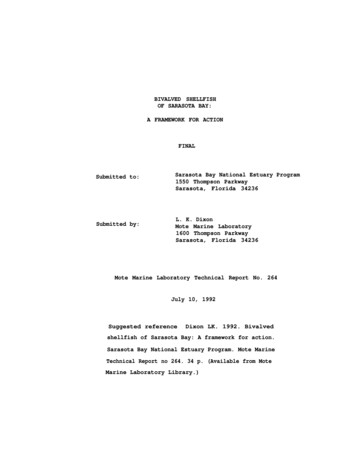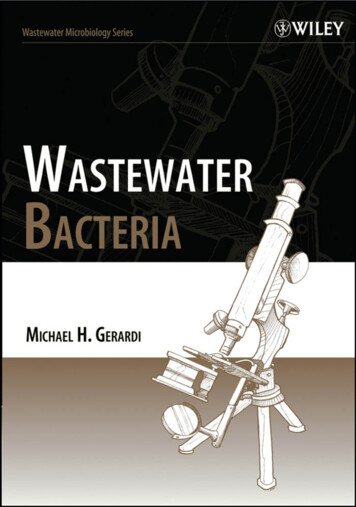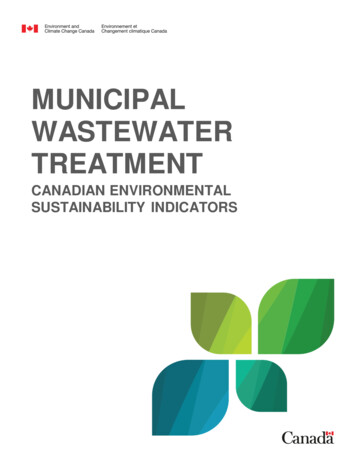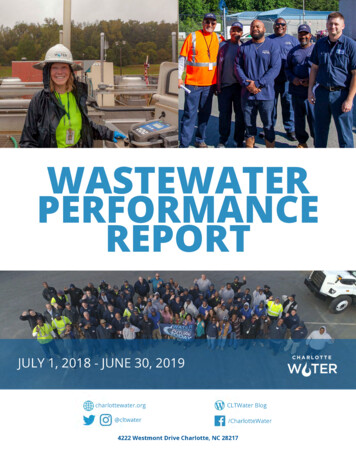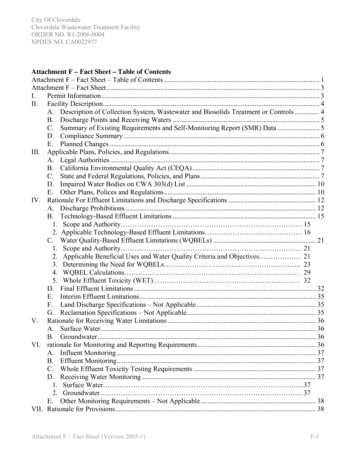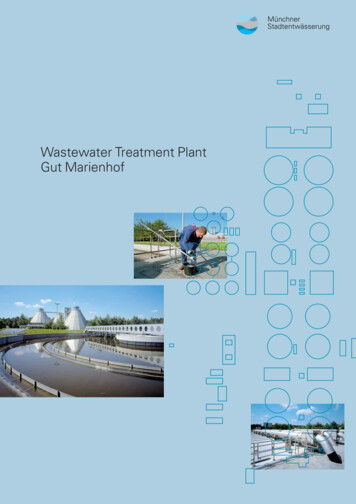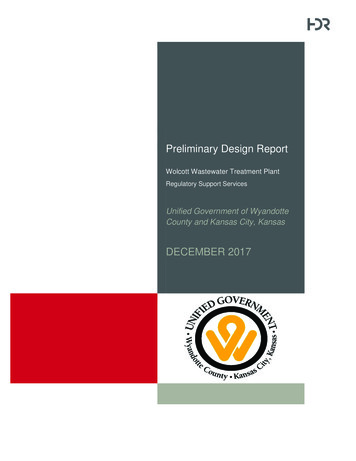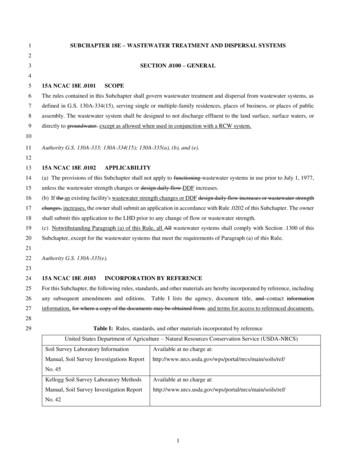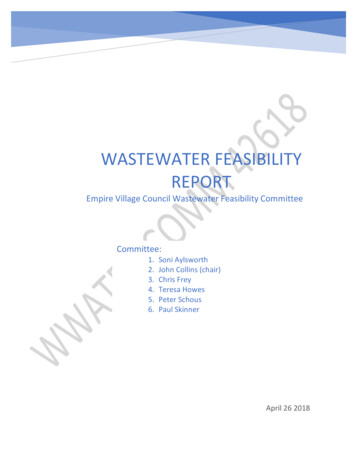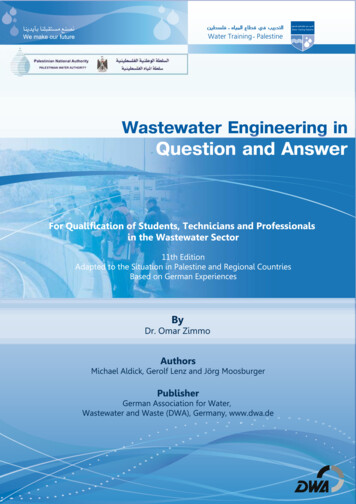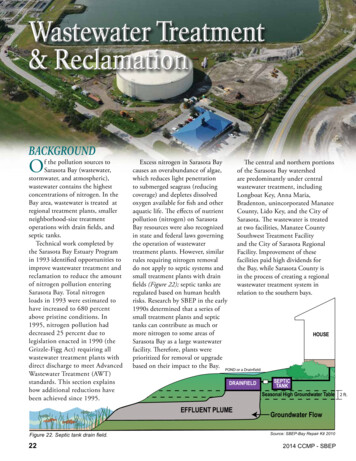
Transcription
Wastewater Treatment& ReclamationBACKGROUNDOf the pollution sources toSarasota Bay (wastewater,stormwater, and atmospheric),wastewater contains the highestconcentrations of nitrogen. In theBay area, wastewater is treated atregional treatment plants, smallerneighborhood-size treatmentoperations with drain fields, andseptic tanks.Technical work completed bythe Sarasota Bay Estuary Programin 1993 identified opportunities toimprove wastewater treatment andreclamation to reduce the amountof nitrogen pollution enteringSarasota Bay. Total nitrogenloads in 1993 were estimated tohave increased to 680 percentabove pristine conditions. In1995, nitrogen pollution haddecreased 25 percent due tolegislation enacted in 1990 (theGrizzle-Figg Act) requiring allwastewater treatment plants withdirect discharge to meet AdvancedWastewater Treatment (AWT)standards. This section explainshow additional reductions havebeen achieved since 1995. Figure 22. Septic tank drain field.22Excess nitrogen in Sarasota BayThe central and northern portionscauses an overabundance of algae,of the Sarasota Bay watershedwhich reduces light penetrationare predominantly under centralto submerged seagrass (reducingwastewater treatment, includingcoverage) and depletes dissolvedLongboat Key, Anna Maria,oxygen available for fish and otherBradenton, unincorporated Manateeaquatic life. The effects of nutrientCounty, Lido Key, and the City ofpollution (nitrogen) on SarasotaSarasota. The wastewater is treatedBay resources were also recognizedat two facilities, Manatee Countyin state and federal laws governingSouthwest Treatment Facilitythe operation of wastewaterand the City of Sarasota Regionaltreatment plants. However, similarFacility. Improvement of theserules requiring nitrogen removalfacilities paid high dividends fordo not apply to septic systems andthe Bay, while Sarasota County issmall treatment plants with drainin the process of creating a regionalfields (Figure 22); septic tanks arewastewater treatment system inregulated based on human healthrelation to the southern bays.risks. Research by SBEP in the early1990s determined that a series ofsmall treatment plants and septictanks can contribute as much ormore nitrogen to some areas ofHOUSESarasota Bay as a large wastewaterfacility. Therefore, plants wereprioritized for removal or upgradebased on their impact to the Bay. POND or a DrainfieldDRAINFIELDSEPTICTANKSeasonal High Groundwater Table 2 ft.EFFLUENT PLUMEGroundwater FlowSource: SBEP-Bay Repair2010Not toKitscale2014 CCMP - SBEP
Wastewater Treatment & ReclamationPROGRESS REPORTIWastewater treatment facilities inthe region were upgraded to meetstandards required by the GrizzleFigg legislation beginning in 1990.By 1993, most major facilities were incompliance, including the ManateeCounty Southwest TreatmentFacility, servicing the mainland fromthe City of Sarasota north and thebarrier islands in Manatee County(Anna Maria and Longboat Key).In combination with the City ofSarasota Regional Facility (alsoservicing Lido Key), the two plantsprovided treatment for about 80percent of the Bay surface area.In the early 2000s, localgovernments throughout the regiontested aquifer storage and recovery ofwastewater as a means of eliminatingdischarge. Changes in arsenicstandards by the U.S. EnvironmentalProtection Agency (EPA) prohibitedfull utilization, so deep-well injectionemerged as the alternative backup disposal option in summer wetweather. During the rainy summermonths, the area does not haveenough surface storage capacity tomanage recycled water as demanddeclines for alternative supply.2014 CCMP - SBEPFruitville Wastewater Treatment Plant, Sarasota County.Direct wastewaterdischarge is expected tobe eliminated by 2016.Sarasota County’sseptic tank replacementprogram for PhillippiCreek is approximately65 percent completed.The deep-well option provides forsafe disposal of wastewater.Sarasota County began purchasingsmall wastewater treatment plantsin 1999, to convert those facilitiesinto pumping stations to transportwastewater to regional facilities. Tomeet the demand, Sarasota Countybuilt the Bee Ridge wastewatertreatment facility, a state-of-theart Advance Wastewater Treatment(AWT) facility with reuse and deepwell backup.By utilizing deep well injection,wastewater loads have been reduced95% with additional reductionsanticipated with removal of thetwo remaining discharges (City ofSarasota and Siesta Key) in 2016.Hazen & Sawyer Environmental EngineersWastewater TreatmentPlant UpgradesSarasota Countyn 1990, wastewater contributedabout 50 percent of the totalnitrogen polluting Sarasota Bay.Nitrogen pollution from septicsystems and small wastewatertreatment plants was significant inPhillippi Creek, Roberts Bay, andWhitaker Bayou. Implementationof the Wastewater Treatment andReclamation Action Plan has resultedin most of these nitrogen sources beingreduced by 95 percent.Installation of sewer main, LockwoodRidge Road, Sarasota County.23
Wastewater Treatment & ReclamationPROGRESS REPORT (continued)is transported by ground waterinto tributaries and Sarasota Bay.Analysis of soil types, percolationAnother major componentrates, and horizontal-groundwaterof this action plan is to addresstravel times established a 900-footreplacement of septic systems assafety distance between a septicwell as small treatment plants(Figure 23) not specifically designed tank and a nearby water body. Thisinformation was used in prioritizingto remove nitrogen (Figure 22,areas to receive central wastewaterpage 20). Nitrogen from septicsystems through septic-tanksystem drain fields and treatmentreplacement programs.plants with percolation pondsSeptic Tanks andSmall Treatment PlantsPhillippi Creek, Sarasota.Sarasota CountyPhillippi Creek Septic System Replacement ProgramAREA UNDER DESIGNFUTURE DESIGN/CONSTRUCTIONAREA UNDER CONSTRUCTIONCOMPLETED CONSTRUCTIONDr. Martin Luther King Jr. WayCity of SarasotaN. Beneva Rd.17th St.Fruitville Rd.Cattlemen Rd.Bahia Vista St.Webber St.Siesta Dr.Bee Ridge Rd.The 188-million PhillippiCreek septic tank replacementprogram is approximately 65 percentcomplete, with funding available tocomplete 82 percent of the program.In concert with this program,Sarasota County is consolidating itswastewater treatment plants whileproviding options for reclaimingwastewater. The number of treatmentplants has been reduced from 120 to25, with only nine plants remainingin the Sarasota Bay basin.Septic tanks and small,ineffective wastewater treatmentplants also posed a threat to publichealth. Due to elevated bacterialevels, in 1998 Phillippi Creekwas posted with warning signsindicating the water was unsafefor bodily contact because ofconsistently high bacteria levels.Total nitrogen (and bacteria) levelshave improved in the PhillippiCreek watershed, and PhillippiCreek has been delistedas “impaired” for nutrients.Clark Rd.Gulf Gate Dr.Figure 23.24Source: Sarasota County2014 CCMP - SBEP
Wastewater Treatment & ReclamationReclaimed WaterWastewater wasdetermined to be a valuedsource of alternative supplyto reduce demand onthe aquifer.will be) injected into the groundinto an impermeable saline aquiferapproximately 2,500 feet below thesurface, thus eliminating most directdischarge into Sarasota Bay. Only twodirect discharges remain, with theirremoval scheduled in 2014.In conjunction with the alternativewater supply systems, the municipalitiessurrounding Sarasota Bay have alsoSouthern Water Use Caution Area (SWUCA)HILLSBOROUGHPOLK Manatee Agricultural Reuse SystemMANATEE City of Sarasota ReclaimedWater System (for urban andagricultural reuse)HARDEE Bradenton Reclaimed Water System.DESOTOCHARLOTTEMost Impacted Area (MIA)Figure 24.2014 CCMP - SBEPHIGHLANDerSARASOTAaceRiv Sarasota County’s MasterReuse PlanApproximately 65 percent of thewastewater used in the Sarasota Baybasin is reclaimed for alternativesupply. The remainder of the waterfrom treatment plants is (or soonUpper Peace RiverPINELLASPeStudies conducted by MoteMarine Laboratory in the 1980sshowed decreased salinity inSarasota Bay, suggesting increasingamounts of freshwater inflow.In the early 1990s, the SouthwestFlorida Water Management District(SWFWMD) had advised thecommunity that over-pumpage ofthe Floridian Aquifer was causing theintrusion of saltwater into the aquifer.The Sarasota Bay watershed wasincluded in the Southern Water UseCaution Area (Figure 24), wherestringent water conservation andcontrol measures for withdrawalswere implemented.Wastewater became a valued sourceof water for alternative supply toreduce demand on the aquifer. Aconnection was then made betweenreclaiming wastewater and improvingthe Bay’s water quality (and seagrasshabitats) by reducing or eliminatingdischarge of wastewater into the Bayor tributaries.The SBEP and SWFWMD cochaired a task force comprised localgovernmental staff in the region,resulting in development of aregional plan to reclaim wastewater.Major features of this reclamationplan included:developed a regional water-usesystem through the Peace ManasotaRegional Water Supply Authority.This collaboration included thedevelopment of the Peace RiverOption to augment the ManateeCounty Reservoir, Sarasota CountyCarlton Preserve, City of BradentonReservoir, Carlton Reserve, andthe City of Sarasota’s Verna WellField. As part of the regional effort,water conservation programs wereimplemented that cut per capitaconsumption from 150 g/day to 86 g/day, reducing the amount of effluentpossibly polluting the Bay.The replacement of septic tanksand small wastewater treatmentplants in Sarasota County alsoprovided increased opportunities toreclaim wastewater, as the systemshave greater capability to processwastewater for alternative supply.Southern Water UseCaution Area (SWUCA)Ridge Lakes Areawithin SWUCAUpper Peace RiverSource: SWFWMD25
Wastewater Treatment & ReclamationACTION PLANGOAL:OBJECTIVE 1.0:OBJECTIVE 4.0:Improve water transparency.Wastewater treatment andreclamation policies should beconsistent throughout the region.Develop a wastewater reclamationprogram to eliminate discharge toSarasota Bay.ACTION 1.1:ACTION 4.1:Local governments in the SarasotaBay region should require byordinance, and appropriatemonitoring and enforcement,the wastewater treatment policiesoutlined in the CCMP.ACTION 4.2:POLICIES:All wastewater in the SarasotaBay watershed should betreated to meet or exceedAdvanced WastewaterTreatment (AWT) standardsby the time effluent reachesthe Bay or its tributaries.Septic systems can beacceptable if the septic tanksare located more than 900feet from the Bay or itstributaries and meet currentcode. Treated wastewatershould be reclaimed forreuse. Explore options forzero discharge of wastewaterdirectly in surface waters inthe Sarasota Bay watershed.ACTION 1.2:Educate the public about the needfor consistent policies on wastewatertreatment and reclamation.OBJECTIVE 2.0:OBJECTIVE 5.0:Attain or surpass water qualitystandards (i.e., beneficial uses) inwater bodies in Sarasota Bay andits tributaries (also, see StormwaterTreatment & Prevention ActionPlan on page 33, Objective 5.0).All segments of Sarasota Bay meetstate water quality standards.OBJECTIVE 3.0:ACTION 5.1:Provide centralized wastewatertreatment throughout the PhillippiCreek area.Set resource-based water qualitytargets providing a framework forthe establishment of site-specificalternative criteria.ACTION 3.1:ACTION 5.2:ACTION 3.2:26Explore options for alternativesupply, including the use of treatedwastewater or potable water, aquiferrecharge and protection, and otheruses in the Southern Water UseCaution Area.Continue to use excess capacityof the City of Sarasota wastewatertreatment facility to provide sewerservice to areas with inefficient septicsystems and package treatmentplants to maximize collection andtreatment of wastewater.Complete septic tank replacement andwastewater treatment plant consolidation in northern Sarasota County.Sewer pipe at Hudson Bayou,City of Sarasota.Reconsider a regional program toreclaim treated wastewater.Remaining privately ownedutilities should upgrade to meetthe Wastewater Treatment andReclamation policies in thisAction Plan.Develop and participate in thepreparation of Basin ManagementAction Plans for “impaired” watersor to meet established waterquality targets.2014 CCMP - SBEP
Wastewater Treatment & ReclamationPERFORMANCE MEASUREMENTS & RESULTSIn 1995, performancemeasurements were establishedto evaluate the effectivenessof wastewater treatment andreclamation practices.Currently, all segments of SarasotaBay meet federal and state waterquality standards. No dissolvedoxygen violations have occurred inSarasota Bay since 1998. Seagrasscoverage is 46 percent higher thanin 1988, an indication of improvedwater quality (Figure 4).MEASURE #1:Water quality monitoring dataand biological monitoringwill document measurableimprovements, particularly in butnot limited to Whitaker Bayou,Phillippi Creek, and Roberts Bay.RESULTS 1.3:Fisheries-independent monitoringsuggests good abundance anddiversity of fishery in Sarasota Bay.MEASURE #2:Physical improvements totreatment systems may beincluded in the Sarasota BayEstuary Program’s PollutantLoading Model to calculateachievements in relation tothese actions. The modelestimates that implementingthis strategy will reducenitrogen loadings by up to35 percent in Whitaker Bayou,32 percent in Phillippi Creek,and 24 percent in Roberts Bay.RESULTS 2.1:Chlorophyll a concentrations in allsegments of Sarasota Bay declinedbetween 1998 and 2010.A re-evaluation of the Sarasota Bayprogram pollutant-loading modelindicates a 64-percent reduction innitrogen pollution to Sarasota Bay,exceeding 1995 estimates.RESULTS 1.2:RESULTS 2.2:RESULTS 1.1:This includes a 60-percent reductionin load for Phillippi Creek and anMEASURE #3:Water quality monitoring andbiological monitoring willshow that nitrogen loadingsfrom wastewater treatmentoperations in Manatee Countyremain low.RESULTS 3.1:Biological monitoring (seagrasses)shows the largest increases in seagrasscoverage between 1998 and 2010 inupper Sarasota Bay near the Manateewastewater treatment operation.RESULTS 3.2:Water quality monitoring in thissegment of the Bay has shownsignificant declines in chlorophyll aconcentrations between 1998 and2010. Water quality in this segmentis excellent (USF, 2012).RESULTS 3.3:Seagrass coverage has increased46 percent since 1988; seagrasslevels are 29 percent above 1950.Manatee CountyNo dissolved-oxygen violations weredetected in Sarasota Bay from 1998 to2010, indicating full aquatic lifesupport and use.80-percent reduction in load fromWhitaker Bayou.City of Sarasota influent upgrade.2014 CCMP - SBEP27
Wastewater Treatment & ReclamationACTION PLAN UPDATEThe SBEP worked with theUniversity of South FloridaPolicy Institute and local planningdepartments across the region toincorporate pertinent languageinto the comprehensive planningamendments in the late 1990s,creating the necessary policies toimplement all CCMP action plans.The City of Sarasota’s wastewatertreatment permit and discharge intoWhitaker Bayou were addressedthrough a task force – includingthe City, the Florida Department ofEnvironmental Protection (DEP),the U.S. EPA, SWFWMD, theSBEP, and a citizen representative– that examined the permit issuesand recommended a course of actionin 1993. The permit was revised in1995 to allow additional treatmentof wastewater. An agreement wasreached between the City of Sarasotaand Sarasota County in 2002 toallow for such treatment and increasereclaimed water supplies.Another major component of theplan was to investigate alternativeon-site treatment systems fornutrient removal. The SBEP andthe U.S. Soil Conservation Serviceevaluated alternative systems andtheir relevance to the Sarasota Bayarea. In concert with the EPA, it wasdetermined that these innovativesystems would not adequately treatthe wastewater to meet policiesestablished in the CCMP.In the 1990s, the City of Sarasotaprovided sewer service to residencesin the Whitaker Bayou watershed,while Sarasota County providedsewer service to residents on septictanks in both the Phillippi Creekand Whitaker Bayou watersheds.With regard to reclaimed water,the SWFWMD Manasota BasinBoard financially supported thedevelopment of reclaimed watersystems for alternative supply.Multiple funding sources – local,state, and federal – were used todevelop these multi-functionalsystems. Progress in establishingsustainable infrastructure resultedin major modifications in theCCMP in 2010 and deletions ofmajor elements related to: Revisions to the City of SarasotaWWTP permit An interlocal agreement betweenthe City of Sarasota and SarasotaCounty related to the treatmentand reuse of wastewater Ordinances requiring hookup tocentral sewer Replacement of small wastewatertreatment plants Use of innovative septic tanksManatee County Establishing priorities for treatment.Additions to the action planincluded eliminating wastewaterdischarge and establishing andmaintaining water quality standardsfor the Bay.The Florida DEP adopted therecommended numeric criteriafor Sarasota Bay in December2011 as part of the State Rule. InDecember 2012, the EPA adoptedthe Sarasota Bay numeric nutrientcriteria into federal law. AllSarasota Bay waters are currentlymeeting the standards adopted bythe Florida DEP and the EPA.Manatee County Southwest Water Reclamation Facility.282014 CCMP - SBEP
BAY STEWARDSHIPHOW YOU CAN HELP: Find out how your wastewateris treated. If you are on a septicsystem, talk to your local electedrepresentative about the needto provide sewer service in yourarea to protect Sarasota Bay.This is particularly importantif you live close to the Bay orits tributaries. If a treatment plant provideswastewater treatment in yourarea, request information fromthe utility company on the plant’streatment status and any health orenvironmental violations. Support the community’s effortsto reclaim treated wastewaterfor use in golf courses andagricultural irrigation. Ifreclaimed water is available inyour neighborhood for irrigatingyards, use the water sparinglyto reduce the potential ofpolluting the Bay throughstormwater runoff.As a civic groupmember or educator: Help your organizationor students become informedabout wastewater treatmentand reclamation issues.Schedule a tour of a localtreatment operation orrequest a presentation fromutility operators or governmentagencies involved in these issues.Sarasota CountyAs a property owner:Cistern system.Sarasota County Find out more aboutopportunities for usingreclaimed water for potable useafter additional treatment.Sarasota Central County Water Reclamation Facility.2014 CCMP - SBEP29
Phillippi Creek, Sarasota. PROGRESS REPORT (continued) Sarasota County Wastewater Treatment & Reclamation Figure 23. Source: Sarasota County is transported by ground water into tributaries and Sarasota Bay. Analysis of soil types, percolation rates, and horizontal-groundwater travel times established a 900-foot safety distance between a septic
